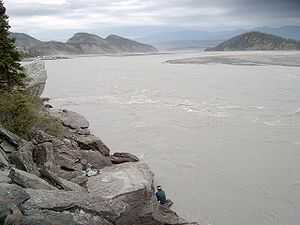Chitina River
| Chitina River | |
 Dipnet fisherman on Copper River at Chitina | |
| Country | United States |
|---|---|
| State | Alaska |
| Census Area | Valdez–Cordova |
| Source | Chitina Glacier |
| - location | Saint Elias Mountains, Wrangell–St. Elias National Park and Preserve |
| - elevation | 3,507 ft (1,069 m) [1] |
| - coordinates | 60°51′40″N 141°24′01″W / 60.86111°N 141.40028°W [2] |
| Mouth | Copper River |
| - location | 1.2 miles (1.9 km) east of Chitina; 66 miles (106 km) northeast of Valdez, Chugach Mountains |
| - elevation | 466 ft (142 m) [2] |
| - coordinates | 61°29′50″N 144°25′10″W / 61.49722°N 144.41944°W [2] |
| Length | 112 mi (180 km) [2] |
 Location of the mouth of the Chitina River in Alaska
| |
The Chitina River (Ahtna Athabascan Tsedi Na’ < tsedi «copper» + na’ «river»[3]) is a 112-mile (180 km) tributary of the Copper River in the U.S. state of Alaska.[2] It begins in the Saint Elias Mountains at the base of Chitana Glacier and flows generally northwest through the Wrangell–St. Elias National Park and Preserve to meet the larger river near Chitina.[4] The watershed was once a major copper mining region.[5]
Recreation
The Chitina River is suitable for floating in rafts, kayaks, and decked canoes by boaters with sufficient wilderness and whitewater skills. From a put-in place near Hubert's Landing, slightly downstream of Chitina Glacier, the river is Class II (medium) on the International Scale of River Difficulty all the way to the mouth at Chitina.[5]
Boaters starting from Hubert's Landing will have to make a difficult 2.5-mile (4.0 km) portage to reach the main river channel. It is also possible to put in at Jake's Bar, about halfway between the glacier and the river mouth. The shorter trip requires no portage.[5]
Hazards include cold silty water, bad weather, and the remote location. Grizzlies pose a danger to boaters, especially near the mouths of clear tributaries, where the bears tend to congregate. A variety of salmon, attractive to bears, migrate to and from these tributaries.[5]
One tributary, the Tebay River, and an associated set of lakes and smaller streams in the Tebay watershed, offer "the potential for some of the finest wilderness angling experiences to be had in Southcentral Alaska", according to Alaska Fishing.[6] The main game fish in the Tebay system are rainbow trout, lake trout, and Arctic grayling.[6]
See also
References
- ↑ Derived by entering source coordinates in Google Earth.
- ↑ 2.0 2.1 2.2 2.3 2.4 "Chitina River". Geographic Names Information System. United States Geological Survey. March 31, 1981. Retrieved December 18, 2013.
- ↑ Ahtna Noun Dictionary and Pronunciation Guide (2nd Edition), 2011, compiled & edited by John E. Smelcer, Ph.D.
- ↑ Alaska Atlas & Gazetteer (7th ed.). Yarmouth, Maine: DeLorme. 2010. pp. 77, 87–88. ISBN 978-0-89933-289-5.
- ↑ 5.0 5.1 5.2 5.3 Jettmar, Karen (2008) [1993]. The Alaska River Guide: Canoeing, Kayaking, and Rafting in the Last Frontier (3rd ed.). Birmingham, Alabama: Menasha Ridge Press. pp. 206–08. ISBN 978-0-89732-957-6.
- ↑ 6.0 6.1 Limeres, Rene; Pedersen, Gunnar, et al. (2005). Alaska Fishing: The Ultimate Angler's Guide (3rd ed.). Roseville, California: Publishers Design Group. pp. 275–76. ISBN 1-929170-11-4.